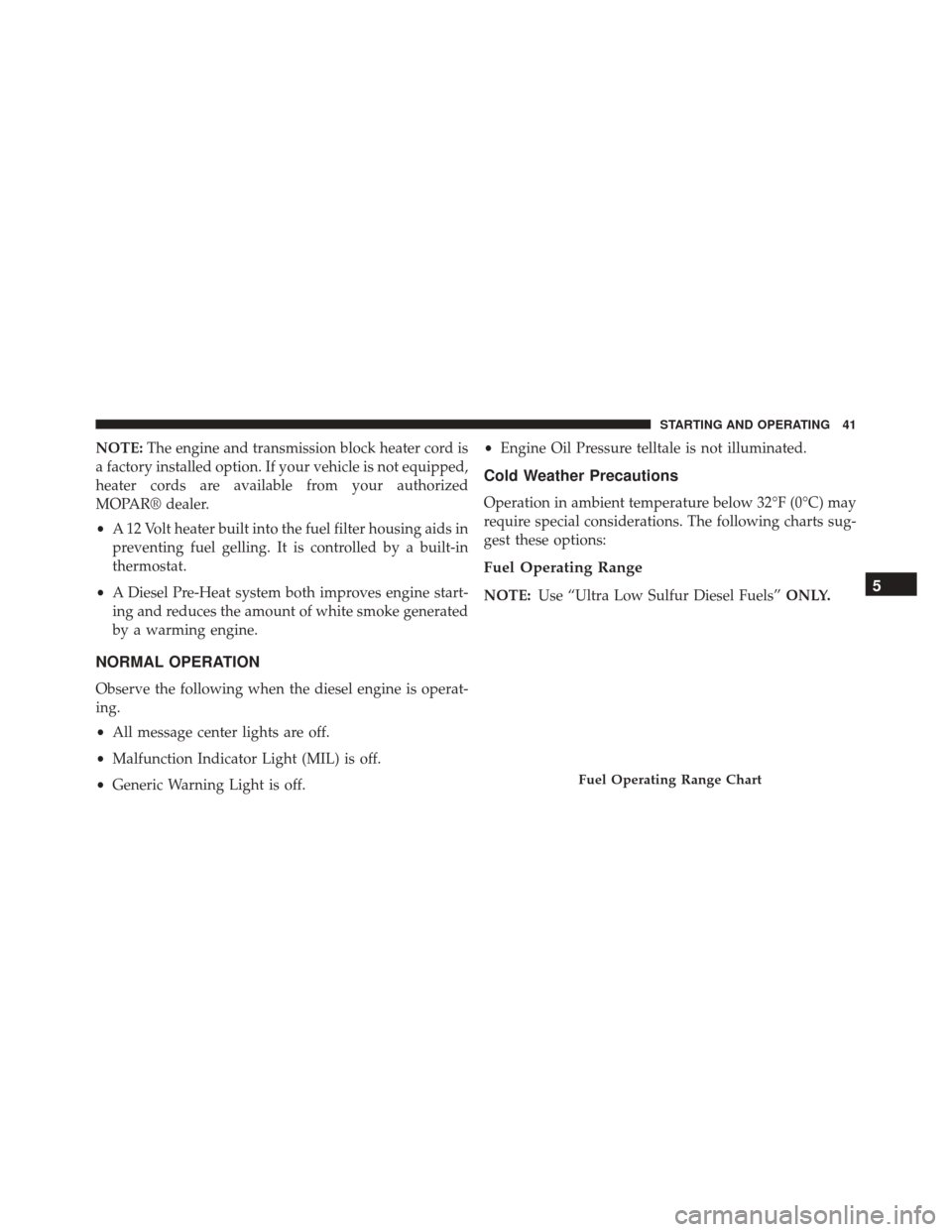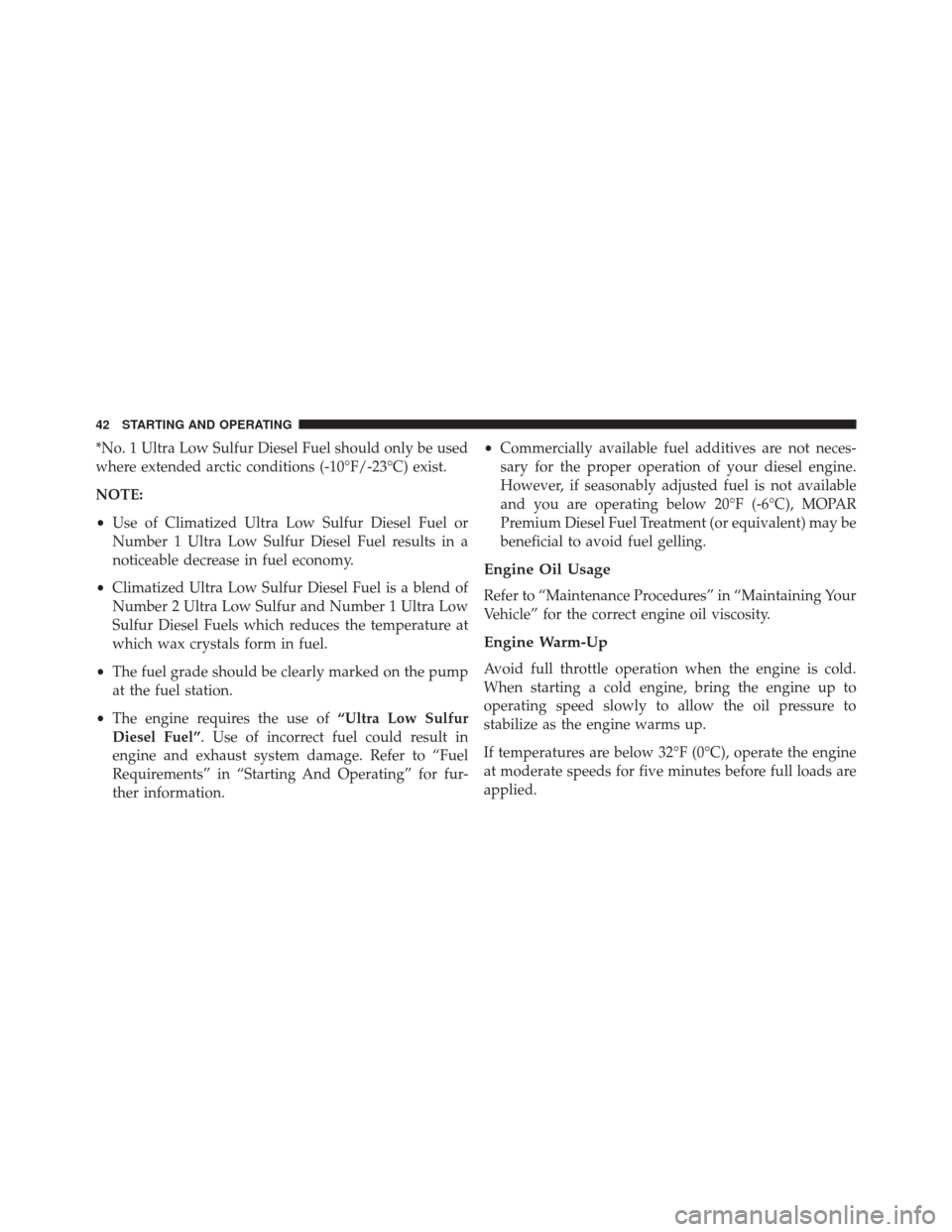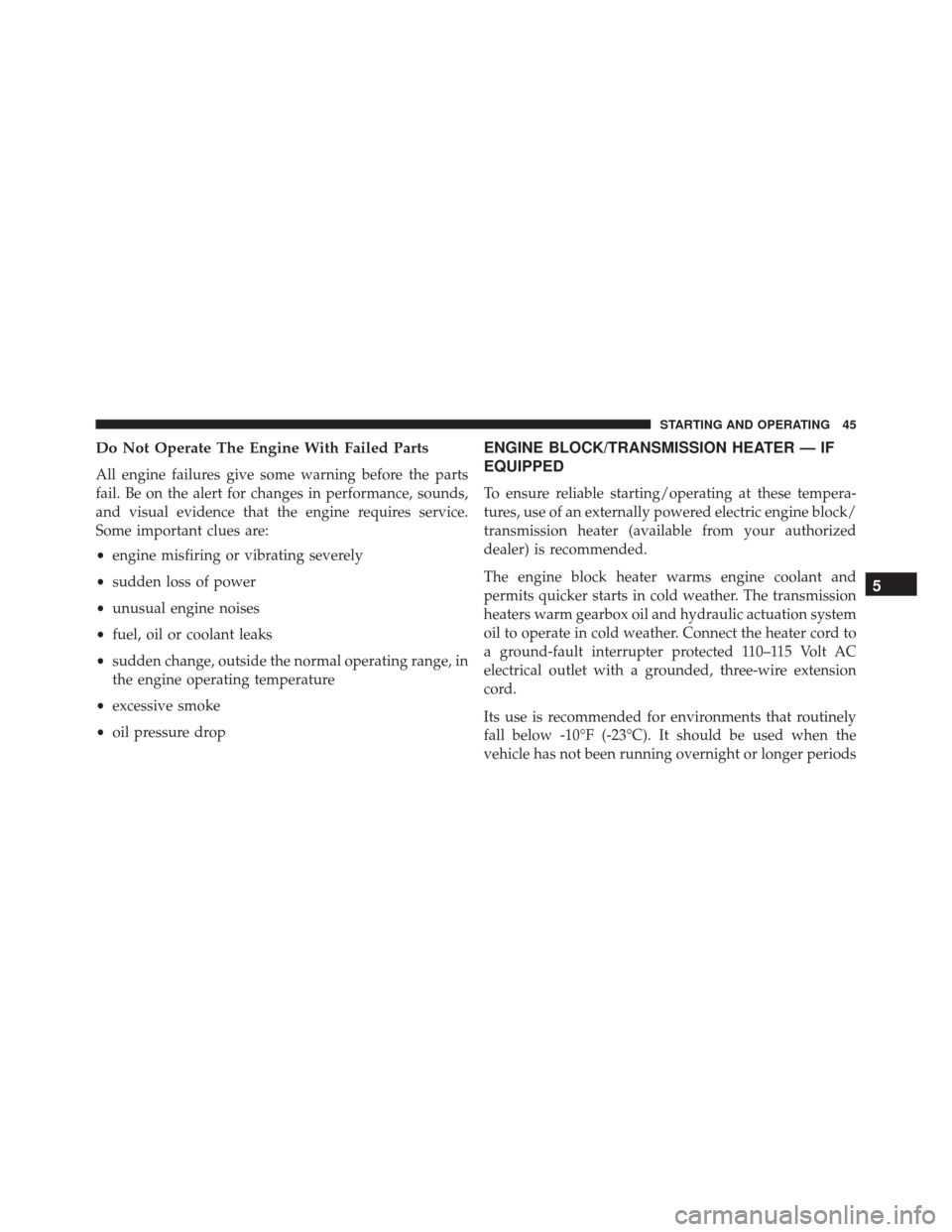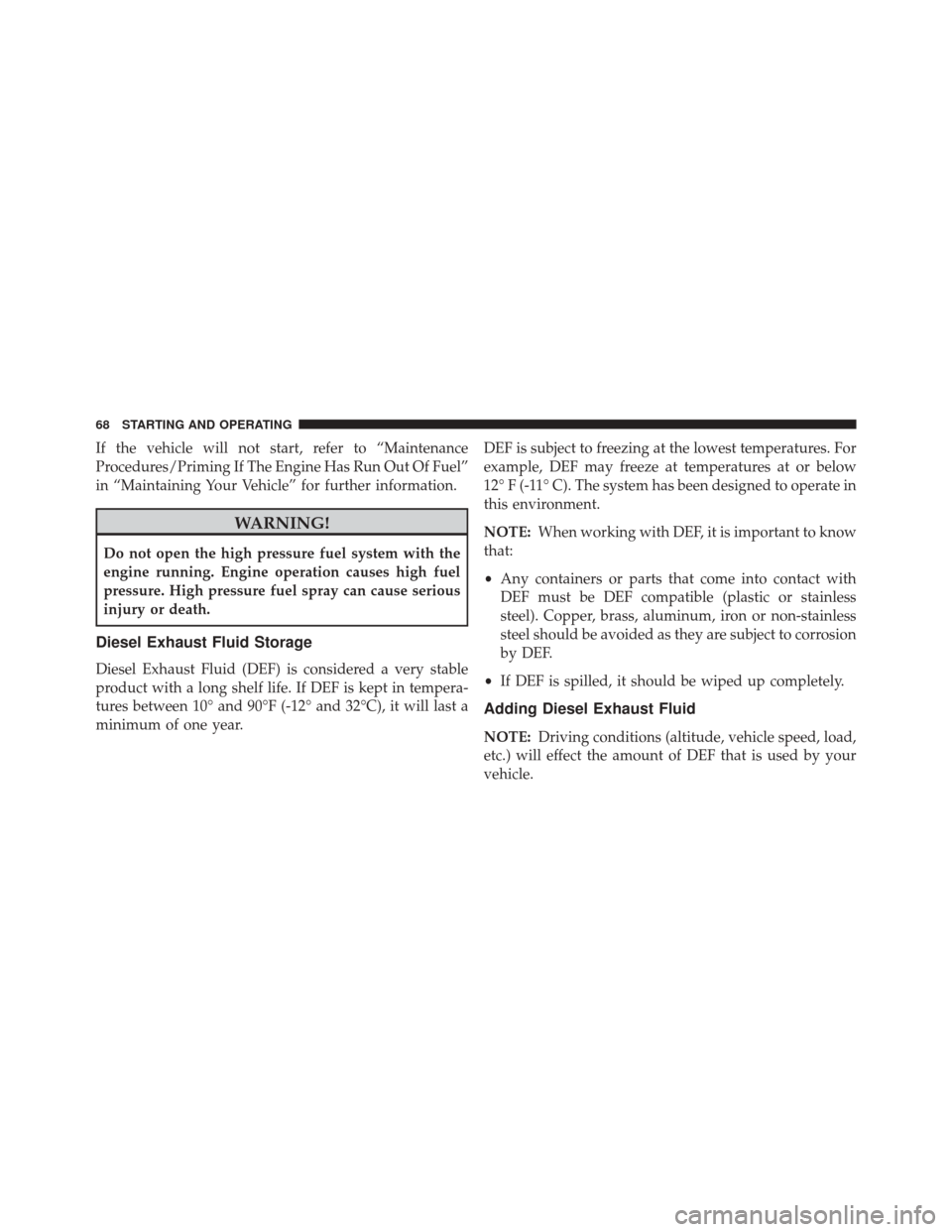2015 Ram ProMaster fuel pressure
[x] Cancel search: fuel pressurePage 10 of 130

ENGINE BREAK-IN RECOMMENDATIONS
The diesel engine does not require a break-in period due
to its construction. Normal operation is allowed, provid-
ing the following recommendations are followed:
•Warm up the engine before placing it under load.
• Do not operate the engine at idle for prolonged
periods.
• Use the appropriate transmission gear to prevent
engine lugging.
• Observe vehicle oil pressure and temperature indica-
tors.
• Check the coolant and oil levels frequently.
• Vary accelerator pedal position at highway speeds
when carrying or towing significant weight. NOTE:
Light duty operation such as light trailer towing
or no load operation will extend the time before the
engine is at full efficiency. Reduced fuel economy and
power may be seen at this time.
The engine oil installed in the engine at the factory is a
high-quality energy conserving type lubricant. Oil
changes should be consistent with anticipated climate
conditions under which vehicle operations will occur.
The recommended viscosity and quality grades are
shown under “Fluids, Lubricants and Genuine Parts”,
under “Maintaining Your Vehicle” in this manual. NON-
DETERGENT OR STRAIGHT MINERAL OILS MUST
NEVER BE USED.
8 THINGS TO KNOW BEFORE STARTING YOUR VEHICLE
Page 27 of 130

23. Generic Warning LightThe Generic Warning Light will illuminate in
blinking mode if any of the following condi-
tions occur:
• Air Bag Warning Light Fault
• Engine Oil Pressure Sensor Failure
• Parking Sensor Failure
• Water In Fuel Presence
• Fuel Cutoff Intervention
• “Engine Minimum Oil Level”
• “Engine Min Oil Sensor Fail”
• Swivel Seat Malfunction
If the Generic Warning Light is blinking an air bag system
failure may be present, see an authorized dealer as soon
as possible. 24. Air Bag Warning Light
This light will turn on for four to eight seconds
as a bulb check when the ignition switch is first
turned to ON/RUN. If the light is either not on
during starting, stays on, or turns on while
driving, have the system inspected at an authorized
dealer as soon as possible. Refer to “Occupant Restraints”
in “Things To Know Before Starting Your Vehicle” for
further information.
25. Tire Pressure Monitoring Telltale Light
Each tire, including the spare (if provided),
should be checked monthly when cold and
inflated to the inflation pressure recommended
by the vehicle manufacturer on the vehicle
placard or tire inflation pressure label. (If your vehicle
has tires of a different size than the size indicated on the
4
UNDERSTANDING YOUR INSTRUMENT PANEL 25
Page 28 of 130

vehicle placard or tire inflation pressure label, you should
determine the proper tire inflation pressure for those
tires.)
As an added safety feature, your vehicle has been
equipped with a Tire Pressure Monitoring System
(TPMS) that illuminates a low tire pressure telltale when
one or more of your tires is significantly under-inflated.
Accordingly, when the low tire pressure telltale illumi-
nates, you should stop and check your tires as soon as
possible, and inflate them to the proper pressure. Driving
on a significantly under-inflated tire causes the tire to
overheat and can lead to tire failure. Under-inflation also
reduces fuel efficiency and tire tread life, and may affect
the vehicle’s handling and stopping ability.
Please note that the TPMS is not a substitute for proper
tire maintenance, and it is the driver ’s responsibility to
maintain correct tire pressure, even if under-inflation has
not reached the level to trigger illumination of the TPMS
low tire pressure telltale.Your vehicle has also been equipped with a TPMS
malfunction strategy to indicate when the system is not
operating properly. When the system detects a malfunc-
tion, the low tire pressure telltale will flash for approxi-
mately one minute and then remain continuously illumi-
nated. This sequence will continue upon subsequent
vehicle start-ups as long as the malfunction exists. When
the low tire pressure telltale is illuminated, the system
may not be able to detect or signal low tire pressure as
intended. TPMS malfunctions may occur for a variety of
reasons, including the installation of replacement or
alternate tires or wheels on the vehicle that prevent the
TPMS from functioning properly. Always check the
TPMS telltale after replacing one or more tires or wheels
on your vehicle, to ensure that the replacement or alter-
nate tires and wheels allow the TPMS to continue to
function properly.
26 UNDERSTANDING YOUR INSTRUMENT PANEL
Page 43 of 130

NOTE:The engine and transmission block heater cord is
a factory installed option. If your vehicle is not equipped,
heater cords are available from your authorized
MOPAR® dealer.
• A 12 Volt heater built into the fuel filter housing aids in
preventing fuel gelling. It is controlled by a built-in
thermostat.
• A Diesel Pre-Heat system both improves engine start-
ing and reduces the amount of white smoke generated
by a warming engine.
NORMAL OPERATION
Observe the following when the diesel engine is operat-
ing.
• All message center lights are off.
• Malfunction Indicator Light (MIL) is off.
• Generic Warning Light is off. •
Engine Oil Pressure telltale is not illuminated.
Cold Weather Precautions
Operation in ambient temperature below 32°F (0°C) may
require special considerations. The following charts sug-
gest these options:
Fuel Operating Range
NOTE: Use “Ultra Low Sulfur Diesel Fuels” ONLY.
Fuel Operating Range Chart
5
STARTING AND OPERATING 41
Page 44 of 130

*No. 1 Ultra Low Sulfur Diesel Fuel should only be used
where extended arctic conditions (-10°F/-23°C) exist.
NOTE:
•Use of Climatized Ultra Low Sulfur Diesel Fuel or
Number 1 Ultra Low Sulfur Diesel Fuel results in a
noticeable decrease in fuel economy.
• Climatized Ultra Low Sulfur Diesel Fuel is a blend of
Number 2 Ultra Low Sulfur and Number 1 Ultra Low
Sulfur Diesel Fuels which reduces the temperature at
which wax crystals form in fuel.
• The fuel grade should be clearly marked on the pump
at the fuel station.
• The engine requires the use of “Ultra Low Sulfur
Diesel Fuel”. Use of incorrect fuel could result in
engine and exhaust system damage. Refer to “Fuel
Requirements” in “Starting And Operating” for fur-
ther information. •
Commercially available fuel additives are not neces-
sary for the proper operation of your diesel engine.
However, if seasonably adjusted fuel is not available
and you are operating below 20°F (-6°C), MOPAR
Premium Diesel Fuel Treatment (or equivalent) may be
beneficial to avoid fuel gelling.
Engine Oil Usage
Refer to “Maintenance Procedures” in “Maintaining Your
Vehicle” for the correct engine oil viscosity.
Engine Warm-Up
Avoid full throttle operation when the engine is cold.
When starting a cold engine, bring the engine up to
operating speed slowly to allow the oil pressure to
stabilize as the engine warms up.
If temperatures are below 32°F (0°C), operate the engine
at moderate speeds for five minutes before full loads are
applied.
42 STARTING AND OPERATING
Page 47 of 130

Do Not Operate The Engine With Failed Parts
All engine failures give some warning before the parts
fail. Be on the alert for changes in performance, sounds,
and visual evidence that the engine requires service.
Some important clues are:
•engine misfiring or vibrating severely
• sudden loss of power
• unusual engine noises
• fuel, oil or coolant leaks
• sudden change, outside the normal operating range, in
the engine operating temperature
• excessive smoke
• oil pressure drop
ENGINE BLOCK/TRANSMISSION HEATER — IF
EQUIPPED
To ensure reliable starting/operating at these tempera-
tures, use of an externally powered electric engine block/
transmission heater (available from your authorized
dealer) is recommended.
The engine block heater warms engine coolant and
permits quicker starts in cold weather. The transmission
heaters warm gearbox oil and hydraulic actuation system
oil to operate in cold weather. Connect the heater cord to
a ground-fault interrupter protected 110–115 Volt AC
electrical outlet with a grounded, three-wire extension
cord.
Its use is recommended for environments that routinely
fall below -10°F (-23°C). It should be used when the
vehicle has not been running overnight or longer periods
5
STARTING AND OPERATING 45
Page 70 of 130

If the vehicle will not start, refer to “Maintenance
Procedures/Priming If The Engine Has Run Out Of Fuel”
in “Maintaining Your Vehicle” for further information.
WARNING!
Do not open the high pressure fuel system with the
engine running. Engine operation causes high fuel
pressure. High pressure fuel spray can cause serious
injury or death.
Diesel Exhaust Fluid Storage
Diesel Exhaust Fluid (DEF) is considered a very stable
product with a long shelf life. If DEF is kept in tempera-
tures between 10° and 90°F (-12° and 32°C), it will last a
minimum of one year.DEF is subject to freezing at the lowest temperatures. For
example, DEF may freeze at temperatures at or below
12° F (-11° C). The system has been designed to operate in
this environment.
NOTE:
When working with DEF, it is important to know
that:
• Any containers or parts that come into contact with
DEF must be DEF compatible (plastic or stainless
steel). Copper, brass, aluminum, iron or non-stainless
steel should be avoided as they are subject to corrosion
by DEF.
• If DEF is spilled, it should be wiped up completely.
Adding Diesel Exhaust Fluid
NOTE: Driving conditions (altitude, vehicle speed, load,
etc.) will effect the amount of DEF that is used by your
vehicle.
68 STARTING AND OPERATING
Page 93 of 130

only when the level on the dipstick is below the mini-
mum notch. The total capacity from the minimum notch
to the maximum notch is 1.7 quarts (1.6 liters).
CAUTION!
Overfilling or underfilling the crankcase will cause
oil aeration or loss of oil pressure. This could damage
your engine.
NOTE: It is possible for your oil level to be slightly
higher than a previous check. This would be due to diesel
fuel that may temporarily be in the crankcase due to
operation of the diesel particulate filter regeneration
strategy. This fuel will evaporate out under normal
operation.
Never operate the engine with oil level below the mini-
mum notch or above the upper maximum notch.
Change Engine Oil
Refer to the “Maintenance Schedule” for the proper
maintenance intervals.
Engine Oil Viscosity (SAE Grade)
CAUTION!
Your vehicle is equipped with an advanced technol-
ogy Diesel Engine and an emission device designed
to limit Diesel Particulate Emissions from being
released into the atmosphere. The durability of your
engine and life expectancy of this diesel particulate
filter emission device is highly dependent on the use
of the correct engine oil.
Only use ACEA C3 SAE 5W-30 Synthetic Low Ash engine
oil meeting FCA US Material Standard MS-11106 or
Pennzoil Ultra Euro L full synthetic 5W-30 motor oil,
6
MAINTAINING YOUR VEHICLE 91